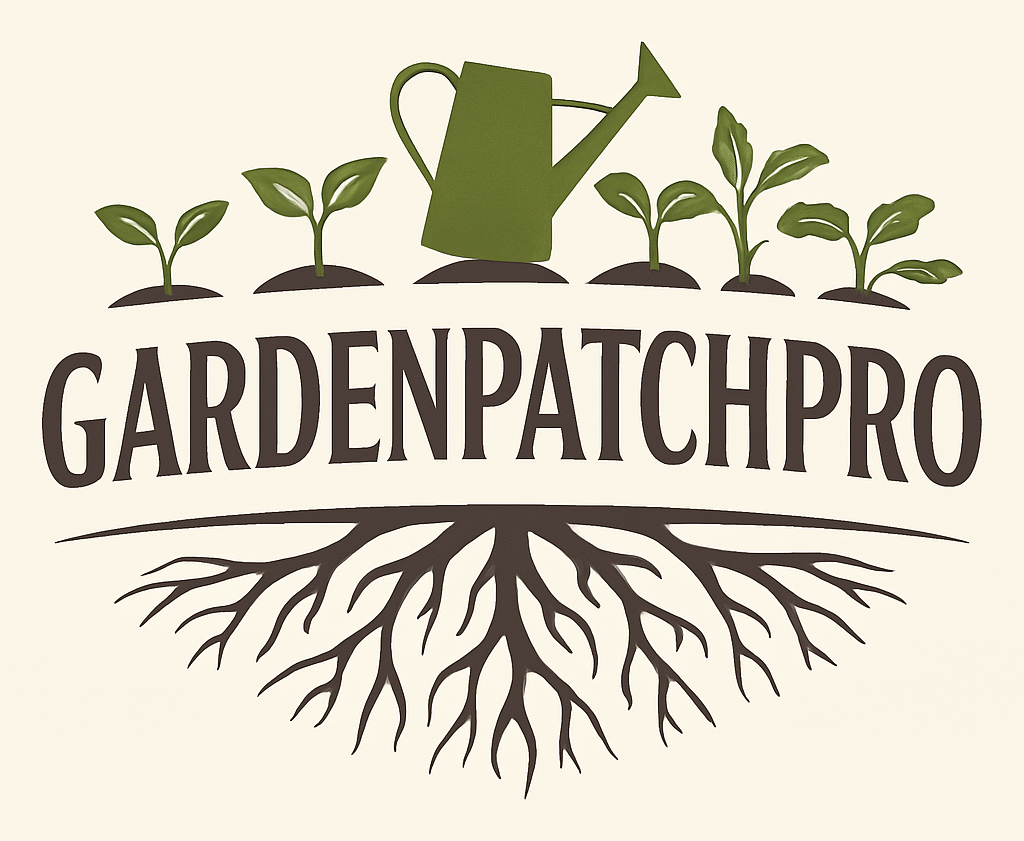11 Air Plants Essential Care Tips for Thriving Greenery
Air plants are unique plants that don’t need soil to grow. They absorb water and nutrients through their leaves, making them easy to care for and versatile for different spaces. Many people choose air plants for their low maintenance and interesting shapes.
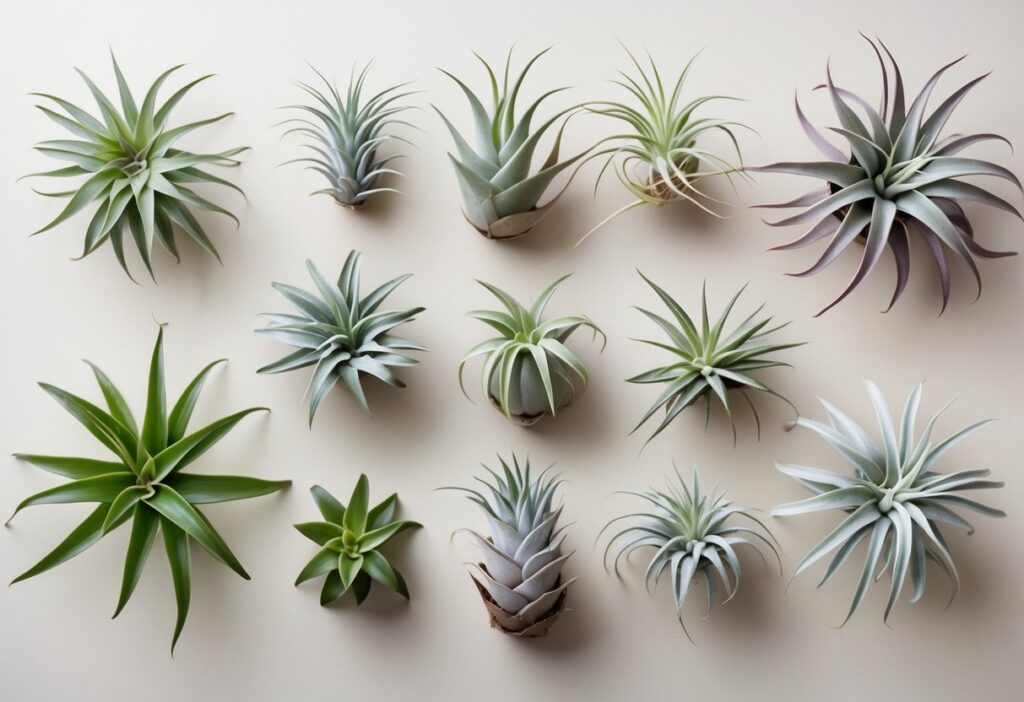
This article covers 11 types of air plants, explaining their key features and care needs. Understanding these varieties helps people pick the right plant for their home or office, ensuring better growth and enjoyment.
1) What Are Air Plants?
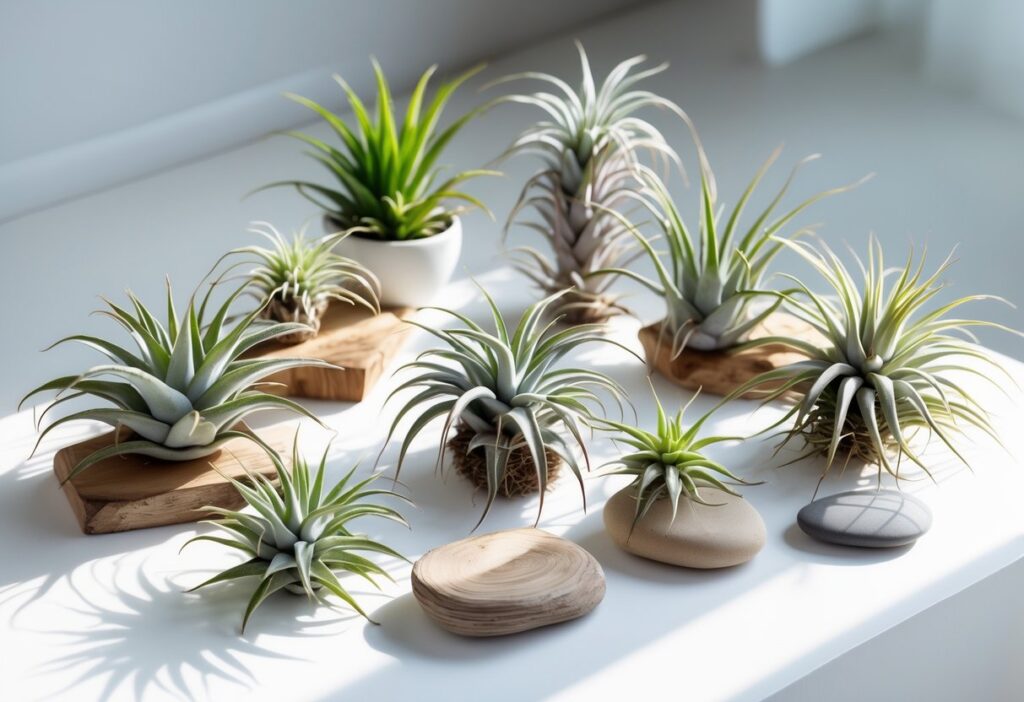
Air plants are a type of plant that does not need soil to grow. Instead, they absorb water and nutrients through their leaves. This makes them different from most other plants that rely on roots in the soil.
They naturally grow on trees, rocks, or other surfaces. Air plants use their roots mainly to hold on to these surfaces, not to get nutrients.
Air plants come in many shapes and sizes. They have unique leaves that can be smooth, curly, or spiky. Their appearance makes them popular for home decoration.
These plants need air circulation and usually bright, indirect light. Some types prefer more sun, while others like shade. Because of their low maintenance, they are easy to care for in many homes.
More detailed information about air plants and their care can be found in the guide on 11 types of air plants.
2) Popular Air Plant Varieties
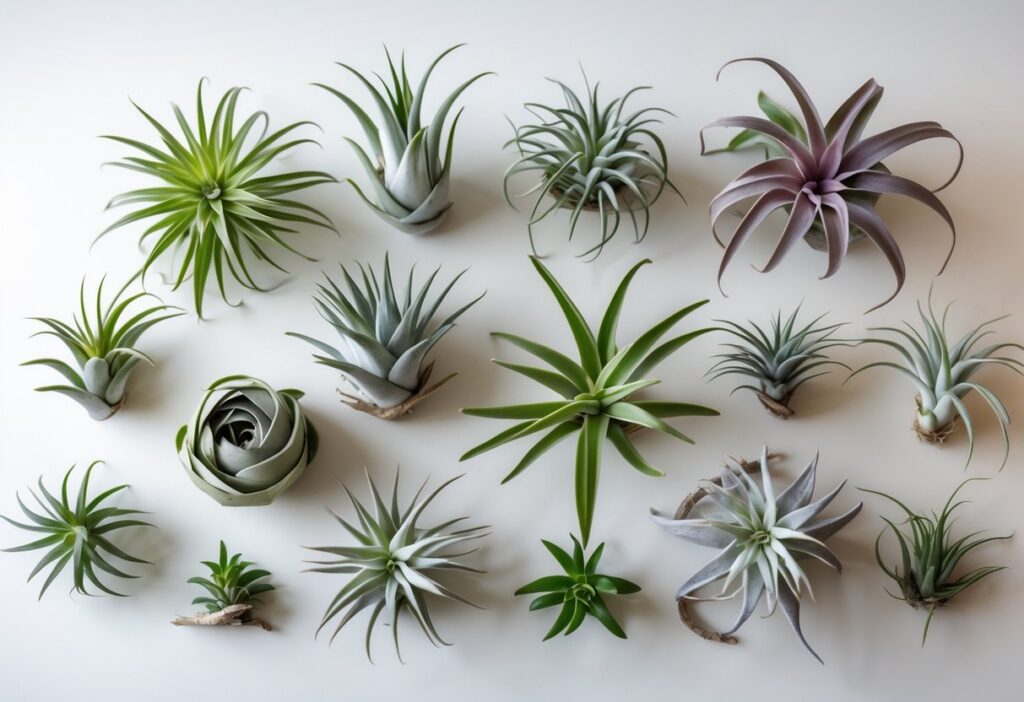
Among air plants, Tillandsia ionantha is one of the most popular varieties. It has small, spiky leaves that turn red or pink when blooming. Its compact size makes it suitable for terrariums and small indoor displays.
Another well-known type is Tillandsia magnusiana. This variety prefers good air circulation and bright, indirect light. It has longer leaves and often appears gray-green with soft hairs.
Tillandsia caput-medusae is also common. Its twisted, thick leaves give it a unique look. It thrives in bright light and needs regular misting to stay healthy.
Many air plants do not require soil and absorb moisture and nutrients through their leaves. This makes them versatile for creative displays around the home.
Learning about different varieties can help people choose the best air plants for their space and care routine. For more details on popular air plant types, see this guide on 11 types of air plants.
3) Ideal Light Conditions
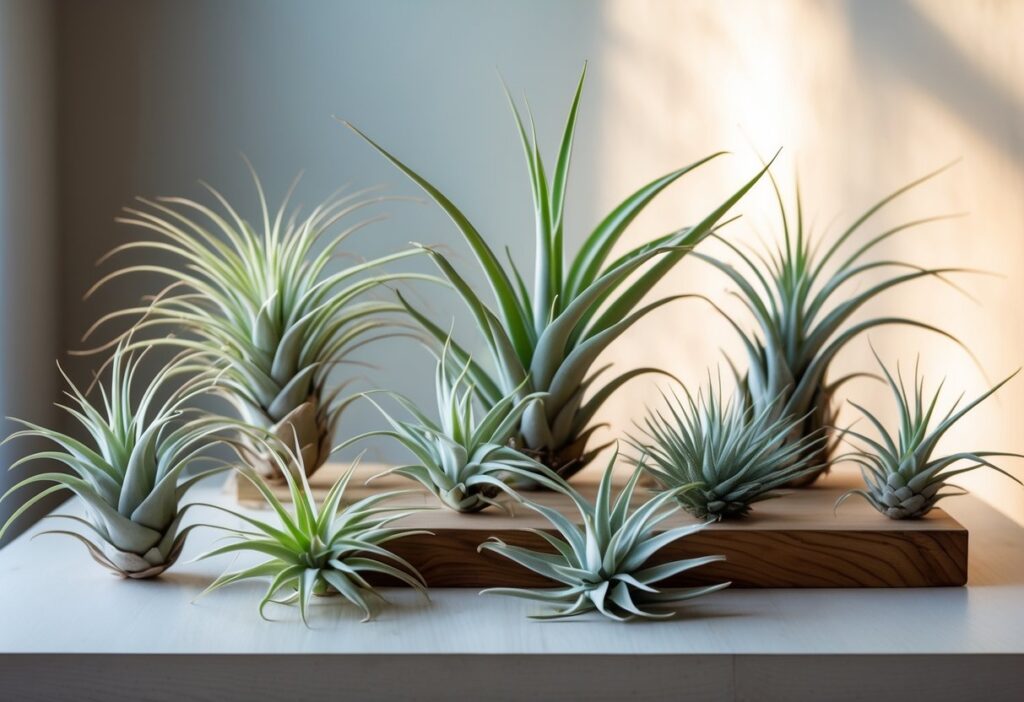
Air plants need bright but indirect light to grow well. Too much direct sunlight can burn their leaves and cause dehydration. On the other hand, too little light will make them weak and dull in color.
They do best near a bright window that gets filtered sunlight. If natural light is limited, fluorescent or LED lights can provide enough light for them to thrive. About 12 to 14 hours of light daily is recommended.
The ideal light level for air plants is between 800 and 1,500 foot-candles. This range supports healthy growth and vibrant leaves. Adjusting the light exposure helps prevent damage while ensuring they get enough energy to live.
It’s important to watch for signs of light problems. Pale or brown spots can mean too much light. If the plant looks dull and stops growing, it might need more light. Proper light care helps air plants stay healthy and colorful.
For more on how to provide the right light for your air plants, see a detailed air plant light guide.
4) Watering Techniques
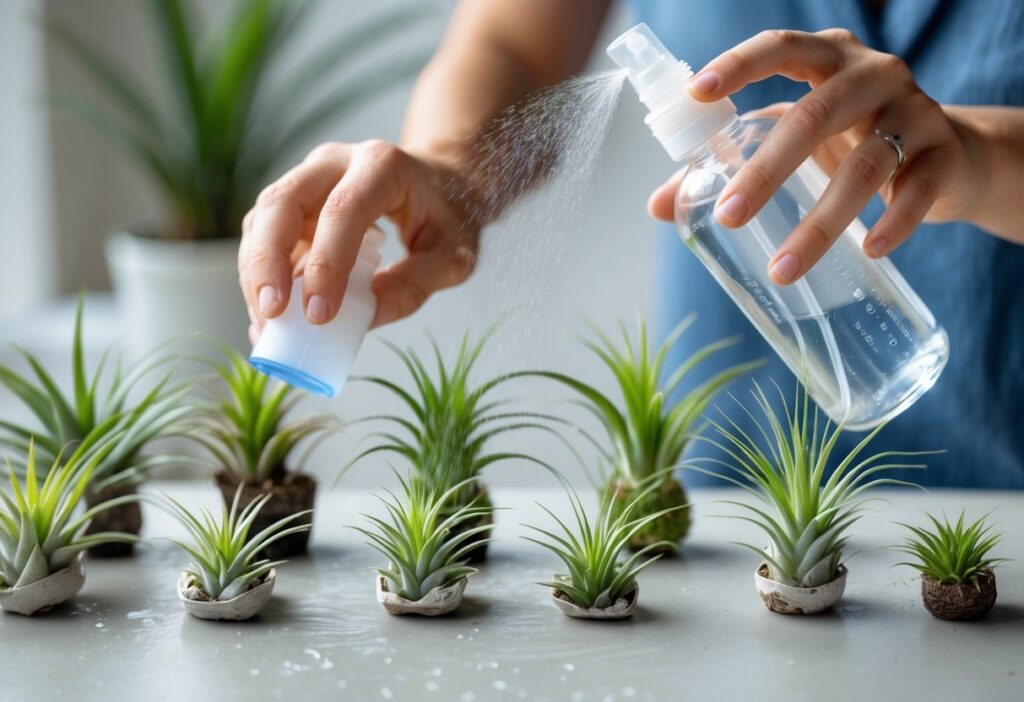
Air plants need water but not soil. The best way to water them is to soak them in water for 20 to 30 minutes once a week. This allows the plant to absorb enough moisture deep into its leaves.
After soaking, it’s important to let the plant dry completely. Leaving it wet for too long can cause rot. Placing it upside down helps water drip away easily.
Misting is another useful technique. It can be done 2 to 3 times a week, especially in dry indoor environments. Misting helps keep the plant hydrated between soaks.
Some air plants may need adjustments based on the climate or season. If the leaves start curling, it usually means the plant needs more water.
Using clean water, like rainwater or filtered water, is best. Tap water with high chemicals can harm the plant over time.
Combining soaking with regular misting gives the best results. This ensures the air plant stays healthy without too much moisture buildup or dryness. For more detailed tips, see this guide on air plant watering techniques.
5) Air Plant Fertilization
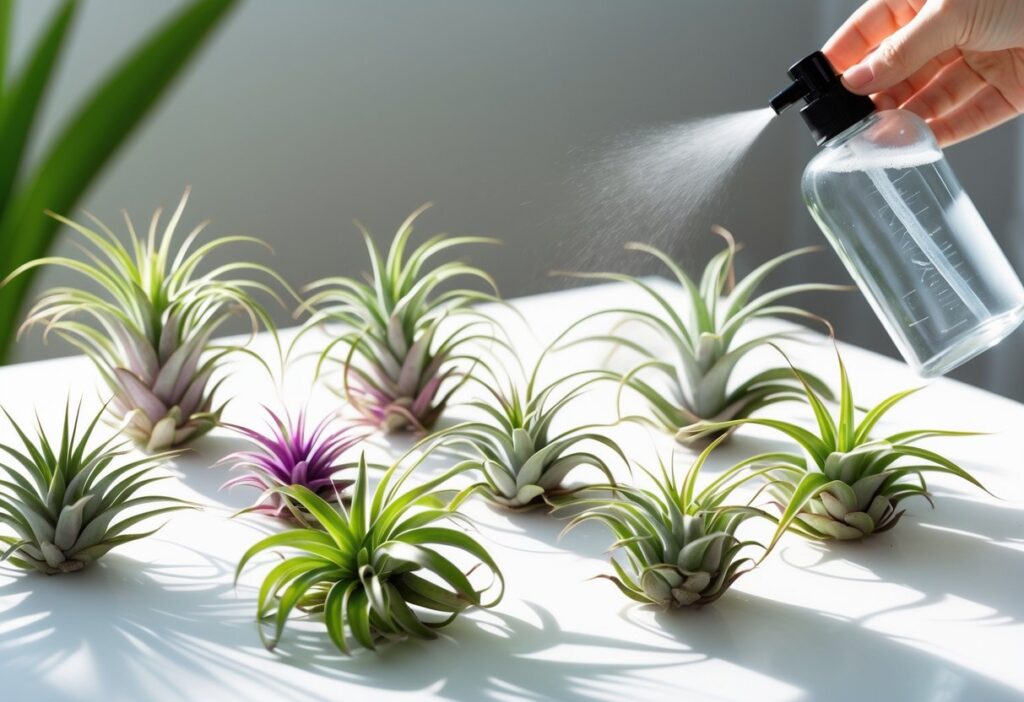
Air plants absorb nutrients through their leaves, so they need regular fertilization to stay healthy. Fertilizing every 2 to 4 weeks during the growing season helps promote growth and vibrant color.
They can be fertilized by soaking or misting with a balanced fertilizer diluted in water. Using a fertilizer made for air plants or bromeliads is best. Avoid fertilizers high in nitrogen, as this can burn the leaves.
During fall and winter, fertilize less often, about once a month or less. Over-fertilizing can harm the plant, so it is better to use less fertilizer than too much.
Regular watering is still necessary even when fertilizing. Fertilizer helps provide extra nutrients but does not replace water.
Following simple fertilizing steps makes it easier to keep air plants healthy. For more detailed instructions, see this guide on how to fertilize air plants.
6) Mounting and Display Ideas
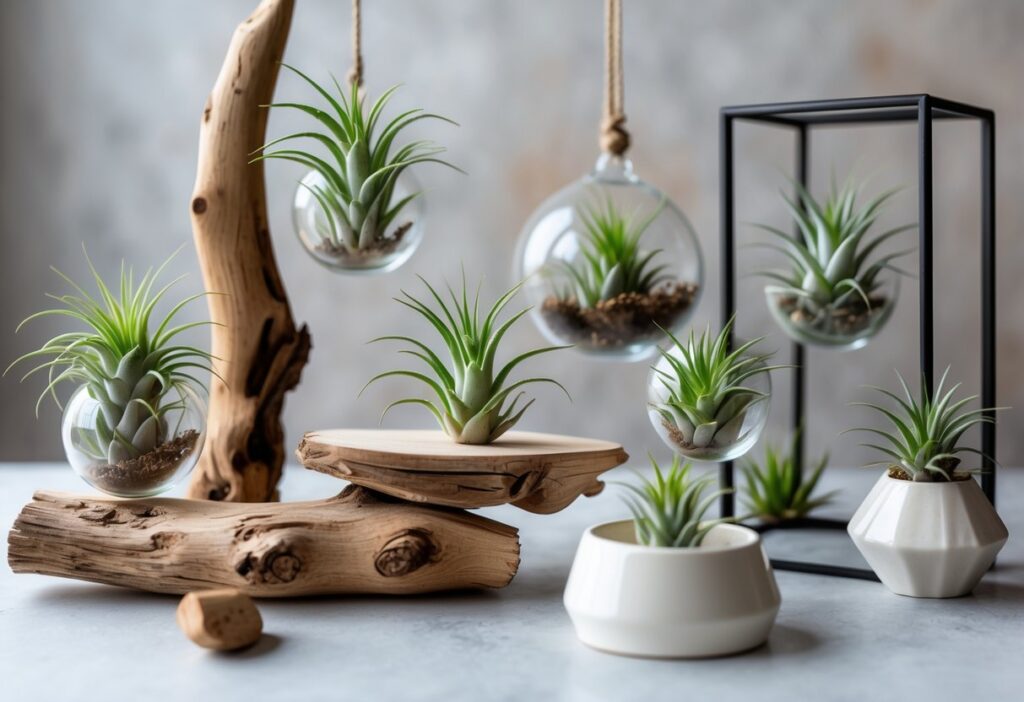
Air plants do not need soil, so they can be displayed in many creative ways. They do best when mounted where they get good airflow.
Common mounts include driftwood, rocks, and seashells. These natural materials create a simple, attractive base. The plants can be attached with thin wire or glue made for plants.
Glass terrariums are popular for showing off air plants. They protect the plants while still allowing light and air to reach them. Hanging glass globes or wall-mounted holders also work well.
Frames with wires can hold several air plants in one display. Old picture frames can be upcycled by adding wire grids to secure the plants. This makes a unique living wall that adds greenery to any room.
Using simple stands or placing air plants on small stones or bark pieces keeps them open to the air, helping them stay healthy. Display ideas that promote airflow can be found at 11 Ideas for Air Plants (Easy Displays).
7) Propagation Methods
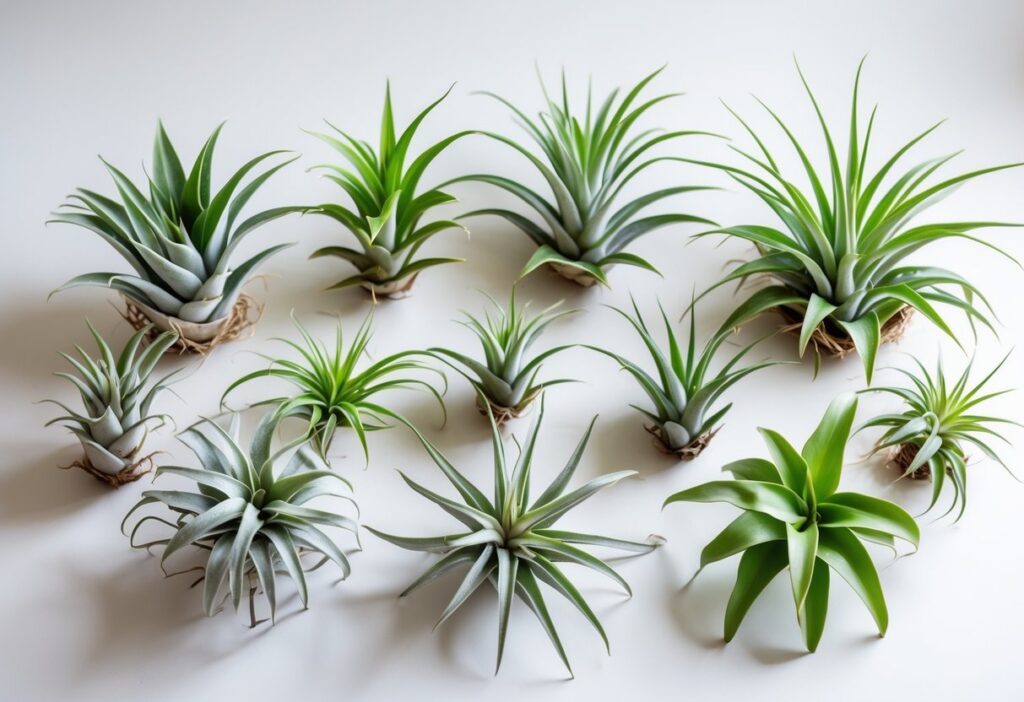
Air plants mainly reproduce through offsets, also called pups. These small plants grow at the base of the mature plant. When the pups reach about one-third the size of the parent, they can be gently separated and grown on their own.
Another method is seed propagation, but it is slower and more difficult. It requires collecting and planting seeds, then waiting months or years for the plants to mature.
Successful propagation depends on good care. The plants need proper light, water, and airflow to grow healthy pups.
Handling the plants carefully and keeping the environment clean helps improve the chances of success. Propagation mostly involves dividing the plants or removing offsets, making it simple for most growers. More details on propagation methods are available in a step-by-step guide.
8) Common Air Plant Problems
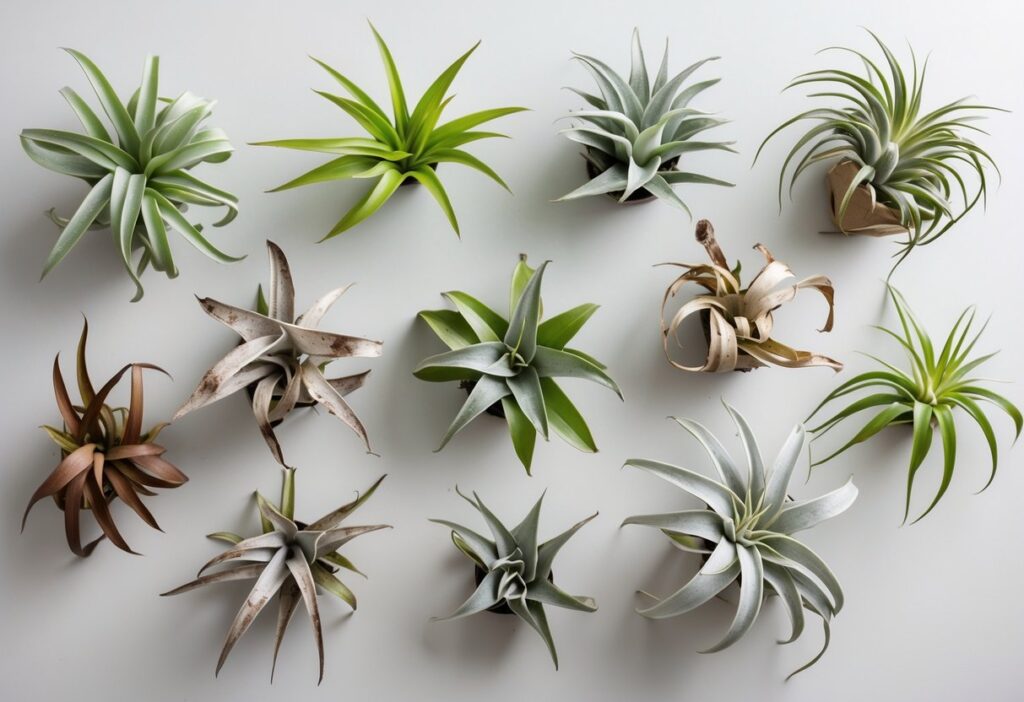
Air plants often face issues related to light. If they do not get enough light, their leaves may curl or turn yellow. Proper lighting is essential for their health.
Overwatering is another common problem. Air plants need to dry out within a few hours after watering. If they stay wet too long, root rot can develop, causing mushy stems.
Poor air circulation can weaken air plants. They thrive in open spaces where air moves freely. Stagnant air can lead to diseases and slower growth.
Sometimes, pests affect air plants. Small bugs may settle on leaves, causing damage. Regular checks help catch these problems early.
Understanding these issues and adjusting care can improve an air plant’s health. For more detailed tips, see common air plant problems explained at plantaddicts.com.
9) Air Plants in Home Décor
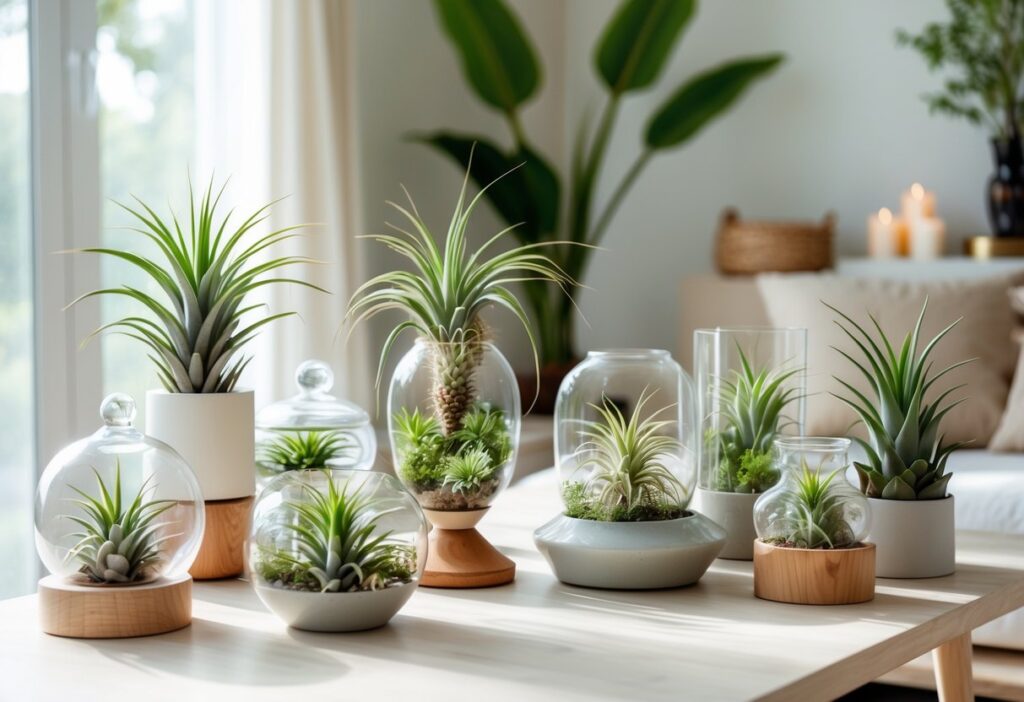
Air plants are popular for home décor because they are easy to care for and fit well in many styles. They do not need soil, so they can be placed in creative ways. This makes them great for adding a natural touch without much effort.
They can be displayed in hanging terrariums, mounted on driftwood, or placed in small containers. Wreaths made with air plants bring a fresh, green look to walls or doors. Their unique shapes add interest and texture to any room.
Air plants work well in modern, rustic, or minimalist designs. They take up little space and can brighten dark corners. Using air plants in home décor is a simple way to bring life and calm to an interior. For more ideas, see air plants in home décor here.
10) Benefits of Growing Air Plants
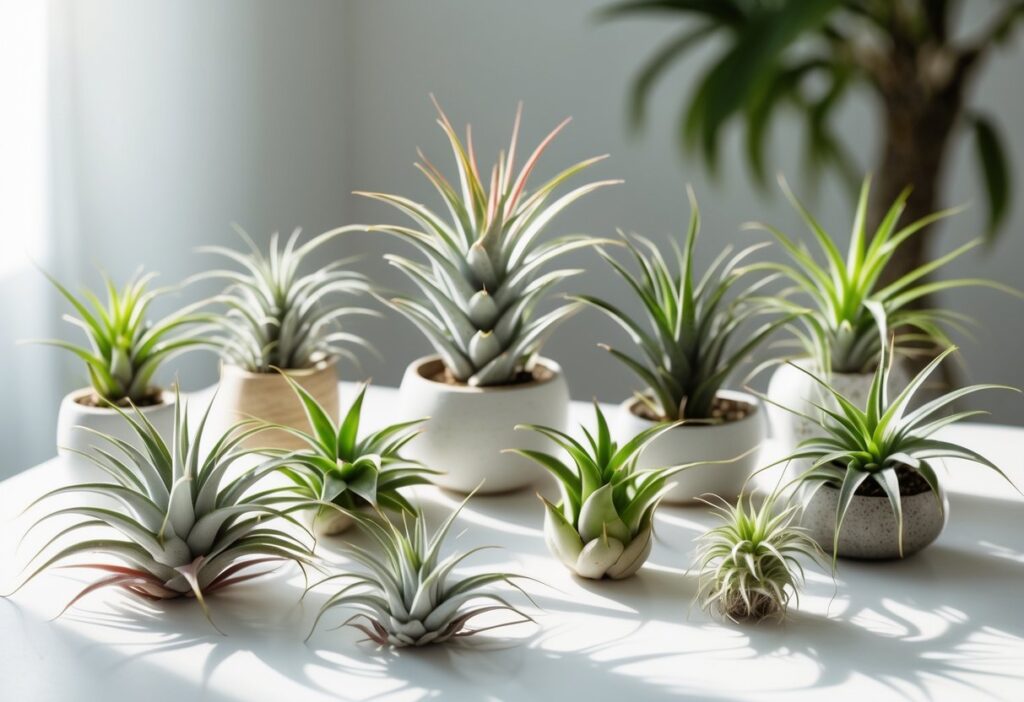
Air plants do not need soil to grow, which makes them very easy to place almost anywhere. They can attach to many surfaces, allowing for creative and space-saving displays.
These plants help improve indoor air quality by filtering out some harmful chemicals. This can make indoor spaces feel fresher and cleaner.
Air plants require very little care. They need only occasional watering and indirect light, making them ideal for busy people or beginners.
They also help reduce stress and boost focus. Being around greenery, like air plants, can create a calming environment at home or work.
Their unique shapes add a decorative touch to any room. They bring natural beauty without the hassle of common houseplants.
Because they are small and adaptable, air plants can fit in tight or unusual spaces. This makes them useful for decorating places where regular plants cannot thrive.
Growing air plants combines easy care with good air quality and stress relief benefits, making them a practical choice for many.
Learn more about the benefits of air plants
11) Seasonal Care Tips
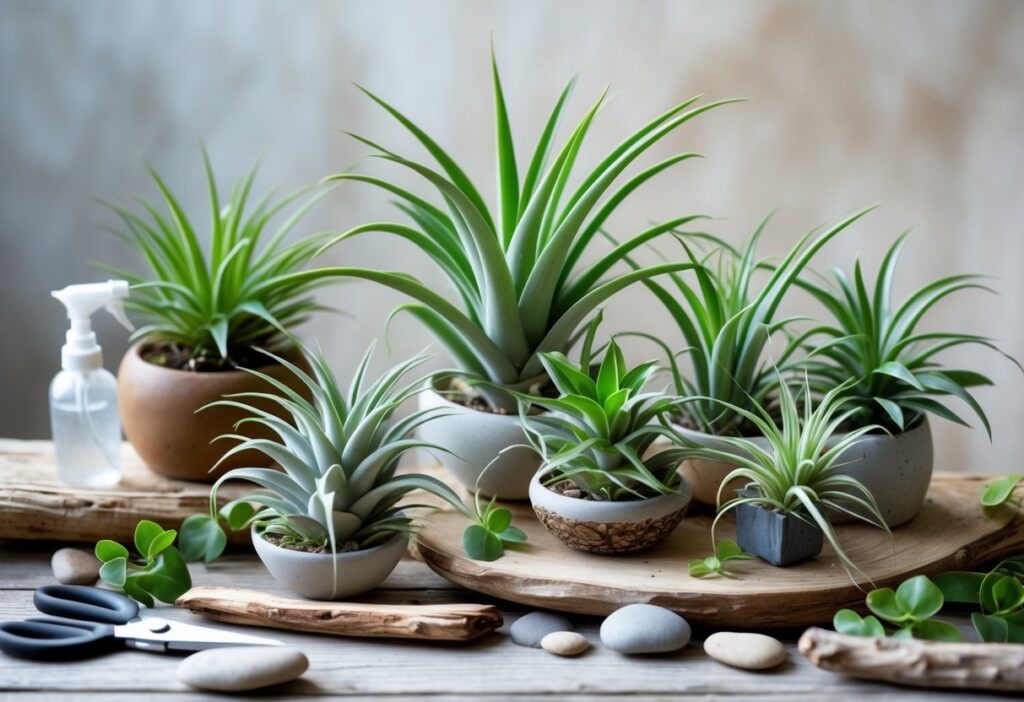
Air plants need different care depending on the season. In warmer months, they thrive in bright, indirect light and benefit from more frequent watering. Soaking them once a week is usually enough to keep them healthy during spring and summer.
During colder months, air plants prefer warmer indoor temperatures above 45°F. They may need less water because they grow slower. Overwatering in winter can cause rot, so soaking them every 10 days or misting lightly is better.
Humidity is important year-round but especially in winter when indoor air is dry. Misting the plants a few times a week helps maintain moisture.
Keeping air plants out of frost and cold drafts is necessary. They do best in temperatures between 50-90°F, making indoor spaces ideal during extreme weather.
Seasonal care ensures air plants stay healthy and continue to grow well. Adjust watering, temperature, and humidity according to the season to support their needs. More details on seasonal care can be found at air plant care guides like this one from Air Plant City.
Essential Care Tips for Air Plants

Air plants need the right amount of light, water, and air to stay healthy. Providing these key factors correctly helps them grow and prevents common problems like rot or drying out.
Light Requirements
Air plants grow best in bright, indirect light. They do well near east or west-facing windows where sunlight is gentle, not direct. Direct sunlight can burn their leaves, causing brown spots or wilting.
If natural light is limited, fluorescent or LED grow lights can work well. They should get about 12 hours of light daily. Avoid placing air plants in dark corners or shady areas, as low light slows their growth and may cause dull coloring.
Watering and Humidity Guidelines
Watering air plants should be done weekly by soaking them in water for 15 to 40 minutes. If soaking isn’t possible, misting 2 to 3 times a week with rainwater or distilled water is an alternative.
After watering, plants need to dry completely within 1-2 hours to avoid rot. It helps to let them dry upside down so water drains away from their base.
Air plants prefer humidity between 50-70%. If the air is dry, misting or placing them near a humidifier can improve their environment.
Proper Air Circulation
Good air circulation is crucial for air plants. Without fresh air, excess moisture stays around the plant, leading to rot and disease.
They should be placed in spaces where air moves freely, such as open shelves or near windows with a breeze.
Air plants should not be kept in sealed containers for long periods since stagnant air causes problems. Consistent airflow helps keep plants healthy and dry after watering.
For more detailed care tips, you can visit this 11 Essential Care Tips for Air Plants guide.
Common Challenges and Troubleshooting
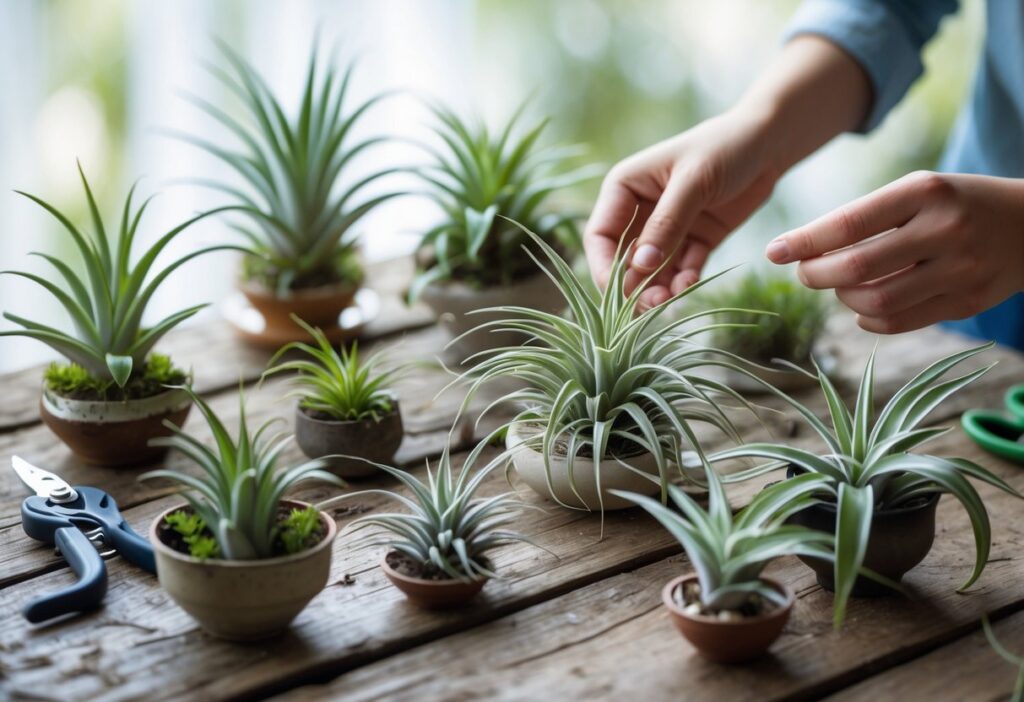
Air plants need the right balance of care to stay healthy. Many problems arise from watering mistakes or environmental stress. Knowing how to spot and fix these issues helps keep air plants thriving.
Preventing Rot
Rot happens when air plants get too much water or stay wet for too long. Signs include a soft, dark base or mushy leaves. To prevent rot, plants should dry completely within 4 hours after watering.
Watering can be done by soaking the plant for 20-30 minutes once a week. After soaking, shake off excess water and place the plant in a spot with good airflow. Avoid using tap water with chemicals; rainwater or filtered water works best.
Rot also develops if air plants are kept in closed containers or areas without proper air circulation. It is important to give them space to breathe.
Reviving Stressed Plants
Signs of stress include brown tips, curled leaves, or dull color. These symptoms often show underwatering, too much sun, or too little humidity.
To revive a stressed air plant, give it a thorough soak and make sure it dries well afterward. Move the plant to indirect light instead of direct sun, which can burn the leaves. Increasing humidity around the plant by misting daily can also help.
If pests are present, gently remove them with a cotton swab dipped in rubbing alcohol. Providing the right care will help the air plant recover its health gradually.
More detailed tips on fixing these problems can be found at Troubleshooting Common Air Plant Problems.
Frequently Asked Questions
Air plants need specific care to stay healthy. Their watering schedule, light needs, and choosing the right types make a big difference. Noticing their condition helps prevent problems early.
What are the care instructions for air plants?
Air plants absorb water through their leaves, not roots. They need bright, indirect light and good air circulation to thrive. Avoid placing them in direct sunlight for too long, as this can dry them out.
How often should air plants be watered?
Most air plants should be soaked in water for about 20-30 minutes once a week. Misting can be added between soaks if the air is dry. After watering, they should dry completely within a few hours to prevent rot.
Which species of air plants are best for beginners?
Tillandsia ionantha and Tillandsia xerographica are popular beginner choices. They are hardy and can tolerate some mistreatment while still growing well. These species do well in common home environments.
What are the ideal conditions for air plant growth?
Air plants prefer bright, filtered light and temperatures between 50-90°F. They need good air movement and humidity, but not constant wetness. Avoid areas with stagnant air or extreme dryness.
How can you tell if an air plant is healthy?
Healthy air plants look firm and have bright green or silver leaves. They do not shrivel or brown at the tips. New growth is a good sign, while softness or dark spots can indicate overwatering or disease.
What are the differences between small and large air plants?
Smaller air plants, like Tillandsia ionantha, dry out faster and may need misting more often. Larger types, such as Tillandsia xerographica, hold moisture longer but require more space and light. Both types absorb water through leaves but have slightly different water needs.
